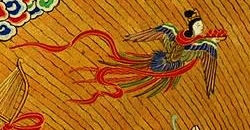


Kalaviṅka (Sanskrit: कलविंक kalaviṅka; Pali: karavika; Chinese: 迦陵頻伽 Jiālíngpínqié;[1] Japanese: 迦陵頻伽, romanized: Karyōbinga,[2] Korean: 가릉빈가;[3] Vietnamese: Ca Lăng Tần Già; Burmese: ကရဝိက် karawik; Thai: การเวก, Malay: karawek) is a fantastical immortal creature in Buddhism, with a human head and a bird's torso, with long flowing tail.[4]
The kalaviṅka is said to dwell in the Western pure land and is reputed to preach the Dharma with its fine voice.[4] It is said to sing while still unhatched within its eggshell.[citation needed] Its voice is a descriptor of the Buddha's voice. In the Japanese text, it goes by various titles such as myōonchō (妙音鳥, "exquisite sounding bird"),[5] kōonchō (好音鳥, "goodly sounding bird")[5] among others.
Edward H. Schafer notes that in East Asian religious art the Kalaviṅka is often confused with the Kinnara, which is also a half-human half-bird hybrid mythical creature, but that the two are actually distinct and unrelated.[6]

The karaweik is commonly used as a motif in traditional Burmese royal barges. The Karaweik located on Yangon's Kandawgyi Lake is an iconic reproduction of the karaweik royal barge.
In Chinese mural art, it is portrayed as a human-headed, bird-bodied being.[citation needed] In the murals of Dunhuang (敦煌) they appear as figures both dancing and playing music.[citation needed]


A well-known example is the pair of kalaviṅka carved in openwork (sukashibori) onto a Buddhist hanging ornament called the keman, used in the golden hall of Chūson-ji temple in Iwate Prefecture. The kalaviṅka from this ornament was commemorated on a 120-yen definitive stamp issued Nov. 1, 1962.[7] The pose and general appearance of this piece are similar to the ones seen on the octagonal pedestal of the same temple (pictured right).
The Kalaviṅka is a common feature of Tangut art created during the Western Xia period (1038–1227).
Kalavinka was born from one of the head of Vishvaroopacharya who was beheaded by Indra. Indra was angry when Vishwaroopacharya was found to be praying for demons instead of gods. Indra cut his three heads which respectively became Kalavinka, Kapinjala, and Tittiri (all birds)[8]
{{cite book}}: CS1 maint: location (link)